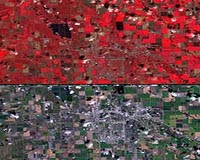 |
Bonn, Germany (SPX) Sep 23, 2009 This image, from the German radar satellite TerraSAR-X, shows the urban region of Munich and the surrounding area. It was acquired on 2 May 2009 at a resolution of 10 metres. The colours in this radar image provide information about how strongly the surface of the Earth reflected back the transmitted radar signals in different polarisations. The urban area is depicted in shades of red and yellow, while agricultural land appears in shades of green with woodland and forest areas shown in shades of blue. This information can, for example, be used to produce land usage maps, as well as for town planning purposes. Polarisation is a property of electromagnetic radiation such as light or the microwaves used in radar systems. This term specifies the orientation of the oscillation plane of these waves relative to their direction of propagation. In general, a distinction is made between horizontal and vertical polarisation of the waves.
Fully polarimetric mode To measure the polarisation orientation of the return signals, the TerraSAR-X antenna is electrically divided into two halves on receive. The front half receives only horizontally polarised waves, while the rear half receives only vertically polarised ones. If, for example, a horizontally polarised impulse is transmitted and reflected back by an object, it may experience a rotation of its polarisation. This means that the reflected impulse would no longer have only a horizontally polarised component, but would instead now also have an additional, vertically polarised component. By virtue of the simultaneous measurement of both these components by the two halves of the antenna, it is possible to determine the extent of the polarisation rotation, which in turn makes it possible to draw conclusions about the reflection process itself. During the sensing process, the satellite acquires four images of the scene simultaneously. If the transmitted impulse is horizontally polarised (H), two images are obtained, designated HH and HV. The first letter denotes the transmitted polarisation while the second letter denotes the received polarisation. If the transmitted impulse is vertically polarised (V), two images, this time designated VH and VV, are obtained.
Improved information content in the recorded image The ploughed areas to the north of Munich appear in different shades of green and can be clearly distinguished from one another. The effect known as 'surface scatter' dominates here. In this case, the radar signal is reflected back to the antenna after a single scattering process. The city area, depicted in shades of red and green, predominantly causes the radar signals to be reflected back from ground and building facades in a two-stage, 'double bounce' reflection process. In woodland and forested areas, shown on the image in shades of blue, the term applied is 'volume scatter', because the signal does not find its way back to the radar antenna until it has been reflected many times between the branches and trunks of the trees. This information is used to produce land usage maps, used for city planning and for the classification and cataloguing of agricultural and forestry areas, and to determine the nature of biomass components.
The TerraSAR-X mission DLR is responsible for using TerraSAR-X data for scientific purposes. It is also responsible for planning and implementing the mission as well as controlling the satellite. Astrium built the satellite and shares the costs of developing and using it. Infoterra GmbH, a subsidiary company founded specifically for this purpose by Astrium, is responsible for marketing the data commercially. Share This Article With Planet Earth
Related Links TerraSAR-X Earth Observation News - Suppiliers, Technology and Application
 Snapshots From Space Cultivate Fans Among Midwest Farmers
Snapshots From Space Cultivate Fans Among Midwest FarmersGreenbelt MD (SPX) Sep 18, 2009 Noreen Thomas' farm looks like a patchwork quilt. Fields change hue with the season and with the alternating plots of organic wheat, soybeans, corn, alfalfa, flax, or hay. Thomas enjoys this view from hundreds of miles above Earth's surface - not just for the beauty, but the utility. She is among a growing group of Midwest farmers who rely on satellite imagery from Landsat to maximize ... read more |
|
| The content herein, unless otherwise known to be public domain, are Copyright 1995-2009 - SpaceDaily. AFP and UPI Wire Stories are copyright Agence France-Presse and United Press International. ESA Portal Reports are copyright European Space Agency. All NASA sourced material is public domain. Additional copyrights may apply in whole or part to other bona fide parties. Advertising does not imply endorsement,agreement or approval of any opinions, statements or information provided by SpaceDaily on any Web page published or hosted by SpaceDaily. Privacy Statement |